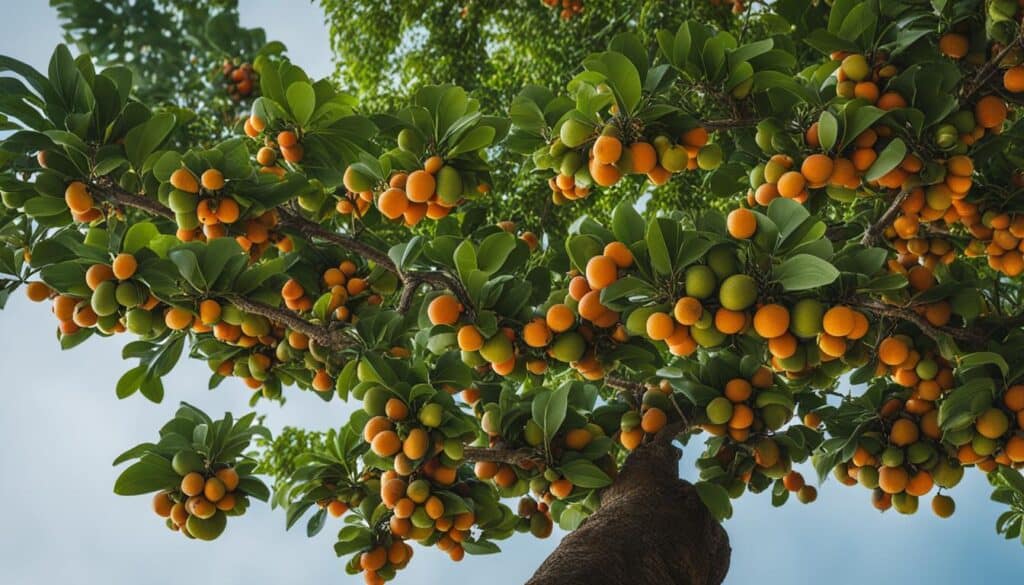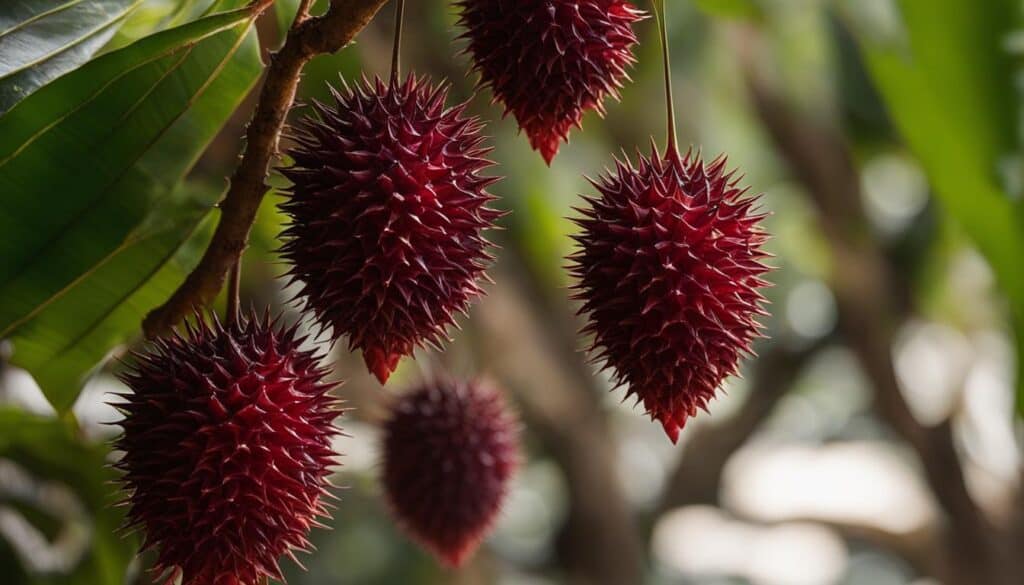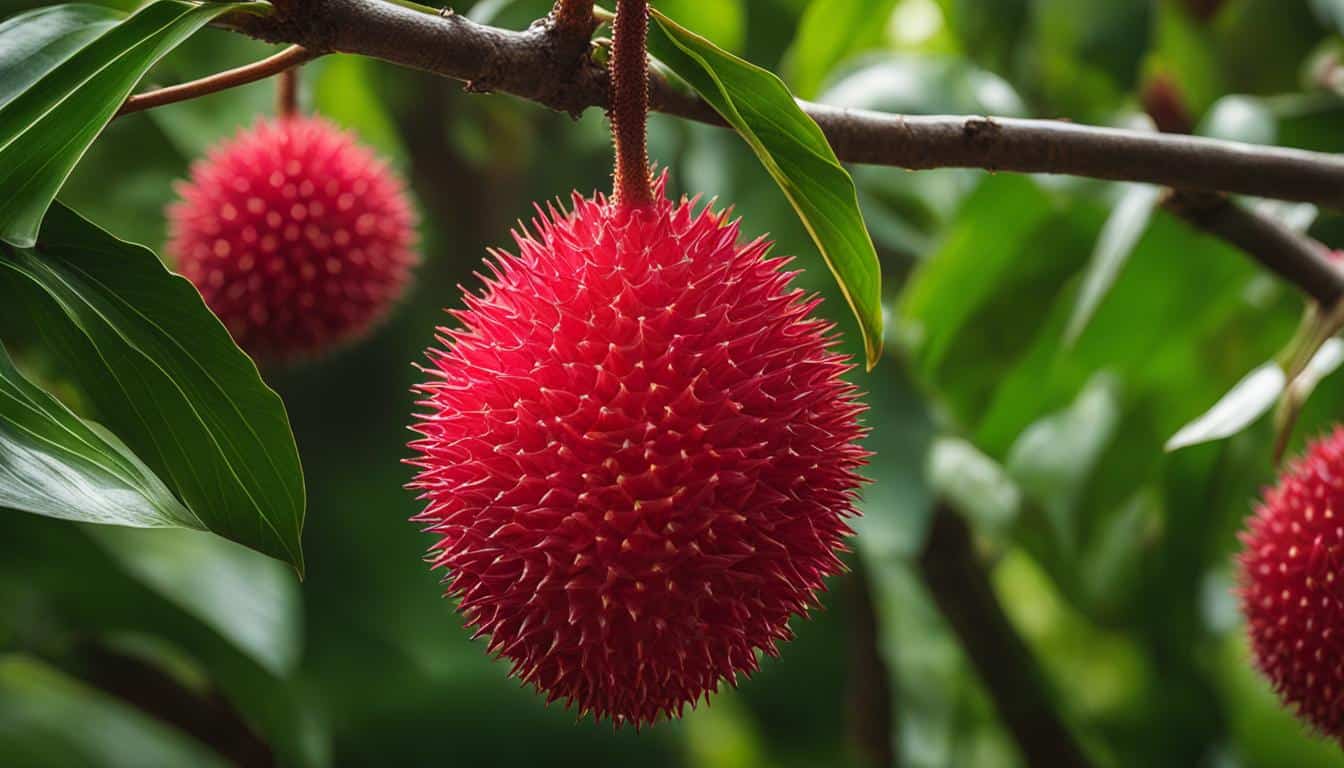Welcome to the tantalizing world of pulasan, a tropical fruit native to Southeast Asia that is sure to delight your taste buds. With its vibrant appearance, delicious flavor, and unique twist-open rind, pulasan is a hidden gem in the realm of exotic fruits. Prepare to embark on a culinary adventure as we explore the wonders of this delectable fruit.
Key Takeaways:
- Pulasan is an exotic tropical fruit native to Southeast Asia.
- It is known for its twist-open rind and sweet, juicy flesh.
- Pulasan seeds are edible and have a flavor similar to almonds.
- Incorporating pulasan into your diet can provide health benefits, including a boost to the immune system.
- Discover the versatility of pulasan in both sweet and savory culinary creations.
The Health Benefits of Pulasan: A Nutritional Powerhouse
Pulasan is not just a delicious tropical fruit; it is also a nutritional powerhouse packed with a range of health benefits. From boosting your immune system to promoting digestion, here are some of the reasons why you should consider adding pulasan to your diet:
- Rich in Vitamin C: Pulasan is a great source of Vitamin C, which plays a crucial role in supporting the immune system and protecting against common illnesses.
- High in Fiber: The fruit contains fiber, which aids in digestion, promotes a healthy gut, and helps prevent constipation.
- Packed with Antioxidants: Pulasan is rich in antioxidants, which help combat free radicals in the body and reduce the risk of chronic diseases.
- Contains Essential Minerals: This fruit is also a good source of minerals like potassium and magnesium, which are important for maintaining proper bodily functions.
By incorporating pulasan into your diet, you can enjoy its delicious taste while reaping the numerous health benefits it offers. Whether eaten fresh or used in various culinary creations, pulasan is a nutritious addition to any meal.
“Pulasan is not just a delicious tropical fruit; it is also a nutritional powerhouse packed with a range of health benefits.”
Table: Nutritional Value of Pulasan (Per 100g)
| Nutrient | Amount |
|---|---|
| Calories | 68 |
| Carbohydrates | 17g |
| Fiber | 1.1g |
| Fat | 0.4g |
| Protein | 0.9g |
| Vitamin C | 48mg |
| Potassium | 42mg |
| Magnesium | 9mg |
Source: Nutrition Value
As shown in the table above, pulasan provides a low-calorie option with a good amount of carbohydrates and dietary fiber. It also contains essential vitamins and minerals that contribute to overall health and well-being.
Growing Pulasan: A Guide to Cultivating this Exotic Fruit
For fruit enthusiasts looking to cultivate their own exotic fruits, growing pulasan can be a rewarding endeavor. Native to Southeast Asia, pulasan requires a warm and tropical climate to thrive. Here is a step-by-step guide on how to grow this delicious fruit:
1. Choose the right location:
Pulasan trees require a location that receives ample sunlight. Ensure that the chosen spot has well-drained soil and is protected from strong winds. The tree can reach a height of 10-20 meters, so make sure there is enough space for it to grow.
2. Planting:
There are two options for planting pulasan: seeds or seedlings. If using seeds, plant them directly in the ground or in pots filled with nutrient-rich soil. If using seedlings, carefully transplant them into the desired location.
3. Watering and maintenance:
Pulasan trees require regular watering, especially during dry periods. Keep the soil consistently moist, but avoid overwatering, as this can lead to root rot. Prune the tree as needed to maintain its shape and remove any diseased or dead branches.
4. Patience and harvest:
Pulasan trees typically take 5-6 years to bear fruit, so patience is key. Once the tree starts producing fruit, harvest them when they are fully ripe and have a vibrant color. Twist the rind open to access the juicy and sweet flesh inside.
By following these steps, you can enjoy the satisfaction of growing your own pulasan and indulging in its exotic flavors. Whether you have a large garden or a small backyard, cultivating this tropical fruit is a rewarding experience that brings a touch of Southeast Asia to your home.

Delicious Pulasan Recipes to Try at Home
Pulasan is a versatile fruit that can elevate your culinary creations with its sweet and juicy flesh. Whether you’re looking to satisfy your sweet tooth or add a unique twist to savory dishes, pulasan can be your secret ingredient. Here are some delicious pulasan recipes to inspire your next kitchen adventure:
Pulasan Fruit Salad
Create a refreshing and vibrant fruit salad by combining pulasan with a variety of tropical fruits like mangoes, pineapples, and papayas. Add a touch of lime juice for a tangy kick and garnish with fresh mint leaves. This colorful salad is perfect for a light and healthy dessert or a refreshing snack on a sunny day.
Pulasan Smoothie
Blend pulasan with your favorite dairy or plant-based milk, a handful of spinach, and a drizzle of honey for a nutritious and energizing smoothie. The pulasan’s natural sweetness and creamy texture make it a perfect base for a tropical smoothie. Feel free to add other fruits or a scoop of protein powder to customize your smoothie according to your taste.
Pulasan Tart
Impress your guests with a delicious pulasan tart. Make a buttery crust using crushed biscuits or graham crackers and fill it with a creamy pulasan filling made with cream cheese, sugar, and pulasan flesh. Bake it until golden and serve it chilled. The combination of the crisp crust and the velvety pulasan filling will delight your taste buds.
Get creative with pulasan and let your culinary imagination run wild. Whether you’re experimenting with salads, smoothies, or tarts, pulasan’s unique flavor and tropical charm will surely leave a lasting impression on your taste buds.
Exploring the Culinary Uses of Pulasan Seeds
Pulasan seeds are a hidden culinary treasure, offering a unique and nutty flavor that can elevate your dishes. These seeds have a taste similar to almonds, making them a versatile ingredient in various recipes. Whether you’re baking, making sauces, or experimenting with new flavors, pulasan seeds can add a delightful twist to your culinary creations.
One way to incorporate pulasan seeds into your cooking is by using them in baking. Ground pulasan seeds can be substituted for almond flour in recipes, adding a distinct flavor and texture to your baked goods. Try using pulasan seed flour in cakes, cookies, or even bread for a delicious twist on familiar favorites.
Additionally, pulasan seeds can be pressed to extract oil, which can be used in various culinary applications. The nutty and aromatic oil adds depth of flavor to dressings, marinades, or even as a finishing drizzle over roasted vegetables. Get creative and experiment with pulasan seed oil to add a unique touch to your dishes.
| Culinary Uses of Pulasan Seeds | Recipe Ideas |
|---|---|
| Baking | – Pulasan Seed Flour Pancakes – Pulasan Seed Cookies – Pulasan Seed Bread |
| Cooking | – Pulasan Seed-Crusted Chicken – Pulasan Seed Sauce for Grilled Fish – Pulasan Seed Salad Dressing |
| Oil Extraction | – Pulasan Seed Oil Drizzle for Roasted Vegetables – Pulasan Seed Oil Dressing for Salads – Pulasan Seed Oil Marinade for Grilled Meats |
Whether you’re a seasoned chef or a home cook looking to try something new, don’t overlook the culinary potential of pulasan seeds. With their unique flavor and versatility, these seeds can add a delightful twist to your dishes and elevate your culinary repertoire.

The Environmental Impact
The cultivation of pulasan trees offers additional environmental benefits. These trees help mitigate climate change by absorbing carbon dioxide and releasing oxygen during photosynthesis. Their dense foliage also provides shade, reducing the temperature in their surroundings and potentially lowering energy consumption for cooling purposes.
Furthermore, the pulasan tree contributes to the ecosystem by providing habitat and food for various wildlife species. Animals such as birds, insects, and small mammals rely on the pulasan tree for shelter and sustenance. Preserving and cultivating pulasan trees can help maintain biodiversity and support the overall health of our natural environment.
In conclusion, the pulasan tree is not just a source of delicious fruits; it offers numerous benefits beyond its harvest. From its durable hardwood to its oil and environmental contributions, the pulasan tree is a sustainable resource worth embracing. By recognizing and utilizing the full potential of the pulasan tree, we can promote eco-friendly practices and reduce our impact on the environment.
The Uniqueness of Pulasan: How it Differs from Other Tropical Fruits
Pulasan, an exotic fruit native to Southeast Asia, possesses distinctive qualities that set it apart from other tropical fruits like rambutan. While the two fruits are closely related, pulasan boasts its own unique taste and texture that captivates the palate of fruit enthusiasts.
Visually, pulasan differs from rambutan in its oval shape and absence of hairy spikes on its rind. This makes it visually appealing and easier to handle when compared to its cousin. Once the pulasan’s twist-open rind is peeled away, the delicious, sweet flesh is revealed, tempting the taste buds with its delectable flavor.
Unlike rambutan, pulasan is slightly less juicy but equally enjoyable. Its flesh has a perfect balance of sweetness and subtle acidity, making it a desired delicacy for those seeking out unique and tropical flavors. The taste of pulasan is truly a treat for the senses.
The uniqueness of pulasan extends beyond its appearance and taste. This exotic fruit offers an exciting addition to the culinary world, providing endless opportunities for creativity in the kitchen. From desserts like fruit salads and tarts to savory dishes like stir-fries and salsas, pulasan brings a tropical twist to a wide range of recipes.
“Pulasan stands out among other tropical fruits due to its unique characteristics. Its oval shape, lack of hairy spikes, and distinct taste make it a sought-after delicacy for fruit enthusiasts.”
Exploring the differences between pulasan and other tropical fruits adds to the excitement of discovering new and exotic flavors. With its captivating appearance, delightful taste, and versatility in the kitchen, pulasan truly shines as a fruit worth experiencing.
| Pulasan | Rambutan |
|---|---|
| Distinct oval shape | Round shape |
| Lack of hairy spikes on rind | Pronounced hairy spikes on rind |
| Slightly less juicy | Very juicy |
| Delicious, sweet flesh with subtle acidity | Delicious, sweet flesh |

The Allure of Pulasan
“Pulasan’s vibrant appearance, twist-open rind, and delectable flesh make it a favorite among those who have had the chance to try it.”
Pulasan’s allure lies in its vibrant appearance and unique characteristics. The twist-open rind makes it easy to access the sweet and succulent flesh inside. The fruit itself is a feast for the eyes with its bright red color and distinctive shape.
Once you taste pulasan, you’ll be captivated by its exquisite flavor. The sweetness of the flesh is perfectly balanced, leaving a delightful aftertaste that lingers on your palate.
“Pulasan’s rarity adds to its allure, making it a sought-after delicacy for fruit connoisseurs.”
Being a rare fruit, pulasan holds a certain mystique that adds to its desirability. It’s not commonly found in local grocery stores, making it an exclusive treat for those fortunate enough to come across it.
The elusive nature of pulasan makes it a prized possession for fruit connoisseurs and a conversation starter when shared with others. Its scarcity only enhances the excitement of discovering and savoring this hidden gem.
Pulasan: A Taste of the Tropics at Your Fingertips
Indulge in the exotic and delectable flavors of pulasan, a tropical fruit that brings a touch of paradise to your plate. Native to Southeast Asia, pulasan is a hidden gem in the world of exotic fruits, offering a unique and memorable eating experience. Its vibrant appearance, twist-open rind, and sweet, juicy flesh make it a favorite among those who have had the chance to try it.
Just like its cousin, the rambutan, pulasan is an oval-shaped fruit with a slightly less juicy texture. Its rich and tropical flavor is a delightful blend of sweetness and tanginess, making it an irresistible treat for fruit enthusiasts. Whether you’re lucky enough to be in Southeast Asia, where pulasan is native, or you’re exploring exotic fruit options in your local grocery store, this fruit brings the taste of the tropics right to your fingertips.
With its unique appearance and exceptional flavor, pulasan offers a sensory journey that transports you to the diverse and vibrant world of tropical fruits. Each bite is a celebration of the exotic, with a burst of tropical goodness that tantalizes your taste buds. Whether enjoyed on its own or incorporated into recipes, pulasan is a delightful addition to any culinary adventure.
So why wait? Embrace the allure of pulasan and embark on a flavorful journey through the tropics. Discover the captivating taste of this exotic fruit and savor the essence of Southeast Asia with every juicy bite.
Table: Pulasan Nutritional Comparison
| Nutrient | Pulasan | Rambutan |
|---|---|---|
| Vitamin C (mg) | 22.3 | 20.9 |
| Fiber (g) | 0.9 | 0.9 |
| Antioxidants | High | High |
| Potassium (mg) | 42.4 | 42.6 |
| Magnesium (mg) | 9.1 | 8.2 |
“Pulasan is a tropical delight that offers a unique and memorable eating experience. Its vibrant appearance, twist-open rind, and sweet, juicy flesh make it a favorite among fruit enthusiasts. Whether enjoyed on its own or incorporated into recipes, pulasan brings the taste of the tropics right to your fingertips.”
- Experience the captivating taste of pulasan
- Discover the essence of Southeast Asia
- Savor the exotic flavors with every bite
- Embark on a flavorful journey through the tropics
The Exotic Fruit Feast: Exploring Asian Fruit Varieties
When it comes to exotic fruits, Asia is a treasure trove of unique and delicious options. From the tangy sweetness of the durian to the vibrant purple hues of the mangosteen, Asian fruits offer a sensory experience like no other. Exploring the diverse range of Asian fruit varieties allows you to embark on a culinary adventure that will tantalize your taste buds and expand your palate.
One of the most exciting aspects of Asian fruits is their distinctive flavors and textures. Each fruit carries its own unique taste profile, ranging from creamy to citrusy, and soft to crunchy. For those who enjoy trying new flavors and textures, Asian fruits provide a playground of sensory delights.
Some popular Asian fruits include:
- Rambutan: This fruit resembles pulasan in appearance and is known for its sweet, juicy flesh.
- Dragon Fruit: With its vibrant pink or yellow skin and speckled flesh, dragon fruit is as visually stunning as it is delicious.
- Longan: Similar to pulasan and rambutan, longan has a translucent flesh that is sweet and juicy.
- Jackfruit: This massive fruit can grow up to 80 pounds and has a unique taste that is both sweet and savory.
- Pomelo: Often referred to as the “grandfather of grapefruits,” pomelo is larger and sweeter than its citrus cousin.
Exploring the vast array of Asian fruit varieties not only introduces you to new and exciting flavors but also provides an opportunity to learn about different cultures and traditions. Asian fruits have been an essential part of the region’s cuisine for centuries and are deeply ingrained in the local culinary heritage. By incorporating these fruits into your diet, you can connect with Asian cultures and experience a taste of their rich history.
| Asian Fruit | Taste Profile | Texture |
|---|---|---|
| Rambutan | Sweet, juicy | Soft, slightly firm |
| Dragon Fruit | Mildly sweet, refreshing | Soft, crunchy seeds |
| Longan | Sweet, fragrant | Soft, slightly chewy |
| Jackfruit | Sweet, tropical | Tender, fibrous |
| Pomelo | Sweet, tangy | Juicy, slightly fibrous |
So why not embark on an exotic fruit feast and indulge in the vibrant flavors of Asian fruits? From the pulasan’s twist-open rind to the durian’s infamous aroma, these fruits offer a sensory experience that will transport you to the enchanting markets and tropical landscapes of Asia. Whether you’re a seasoned fruit enthusiast or just beginning to explore the world of exotic flavors, Asian fruits are sure to delight and surprise your taste buds.
The Health Benefits of a Tropical Fruit Diet
Incorporating tropical fruits into your diet can have numerous health benefits. These fruits, including pulasan, are not only delicious but also packed with essential nutrients, vitamins, and antioxidants that support overall well-being. One of the advantages of a tropical fruit diet is that these fruits are high in fiber, which aids digestion and promotes a healthy gut. They also provide a natural source of hydration due to their high water content, helping to keep you hydrated throughout the day.
Tropical fruits like pulasan are also rich in vitamins and minerals that are essential for a healthy immune system. They are particularly high in Vitamin C, which can give your immune system a significant boost and help protect against common illnesses. Additionally, tropical fruits contain antioxidants, which help combat free radicals in the body and reduce the risk of chronic diseases such as heart disease and cancer.
Another advantage of a tropical fruit diet is its potential to support weight management. Tropical fruits are generally low in calories and high in fiber, which can help you feel fuller for longer and prevent overeating. They also provide a natural sweetness that can satisfy your sweet cravings without the need for added sugars. Incorporating a variety of tropical fruits into your meals and snacks can contribute to a balanced and nutritious diet.
Overall, embracing a tropical fruit diet can be a delicious and refreshing way to nourish your body. With their vibrant colors, unique flavors, and a wide range of health benefits, tropical fruits like pulasan are a fantastic addition to any diet. So why not indulge in the tastes of the tropics and enjoy a vibrant and healthy lifestyle?
Conclusion
Discover the tantalizing flavors of pulasan, an exotic fruit native to Southeast Asia. With its twist-open rind and sweet, juicy flesh, pulasan offers a unique and memorable eating experience. Not only is it delicious, but it’s also packed with nutrients that contribute to overall health and well-being.
From its rich vitamin C content to its fiber and antioxidant properties, pulasan brings a range of health benefits to the table. Incorporating this tropical fruit into your diet can support digestion, boost your immune system, and promote a healthy gut. It’s a versatile fruit that can be used in various culinary creations, adding a tropical twist to both sweet and savory dishes.
Embrace the sustainability of the pulasan tree, utilizing its timber for construction and extracting oil from its seeds for renewable energy. Let pulasan’s rarity and unique qualities captivate your taste buds and enrich your culinary journey. With its vibrant appearance and refreshing taste, pulasan is a hidden gem among exotic fruits that promises a flavorful adventure.
So why wait? Explore the world of exotic fruits and embark on a culinary escapade with pulasan. Try out delicious pulasan recipes and indulge in the taste of the tropics. Let pulasan be your passport to a vibrant and memorable sensory experience, adding a touch of exotic flair to your plate.
FAQ
What is the origin of Pulasan?
Pulasan is native to Southeast Asia.
What does the word “pulas” mean?
“Pulas” means “to twist” in Malay, referring to the twist-open rind of the fruit.
Are Pulasan seeds edible?
Yes, Pulasan seeds are edible and have a flavor similar to almonds.
What nutrients are found in Pulasan?
Pulasan is rich in Vitamin C, fiber, antioxidants, potassium, and magnesium.
What kind of climate does Pulasan require to grow?
Pulasan thrives in warm and tropical climates with high humidity and well-drained soil.
How long does it take for Pulasan trees to bear fruit?
Pulasan trees typically bear fruit within 5-6 years of planting.
How can Pulasan be enjoyed in culinary creations?
Pulasan can be added to desserts like salads, smoothies, and fruit tarts, as well as incorporated into savory dishes like stir-fries and salsas.
What can be done with Pulasan seeds?
Pulasan seeds can be used in baking, making nut-based sauces, or ground into a powder as a cocoa substitute. The seeds can also be pressed to extract oil for various applications.
Apart from its fruit, what other uses does the Pulasan tree have?
The Pulasan tree’s wood is commonly used in construction, and its seeds can be used to produce oil for lamps.
How does Pulasan differ from other tropical fruits?
Pulasan has a distinct taste and texture, oval shape, and lacks the hairy spikes seen in rambutan.
Is Pulasan a widely known fruit?
Pulasan is considered a hidden gem in the world of exotic fruits, often sought after by fruit connoisseurs.
Can I find Pulasan outside of Southeast Asia?
Pulasan can be found in local grocery stores in some regions, allowing you to enjoy this tropical fruit no matter where you are.
What other exotic fruits can be found in Asia?
Asia is home to a variety of exotic fruits, including durian, mangosteen, and many more with unique flavors and textures.
What are the health benefits of incorporating tropical fruits like Pulasan into your diet?
Tropical fruits are rich in nutrients, vitamins, antioxidants, and fiber, which can improve digestion, boost immunity, and contribute to skin health and weight management.





Leave a Reply